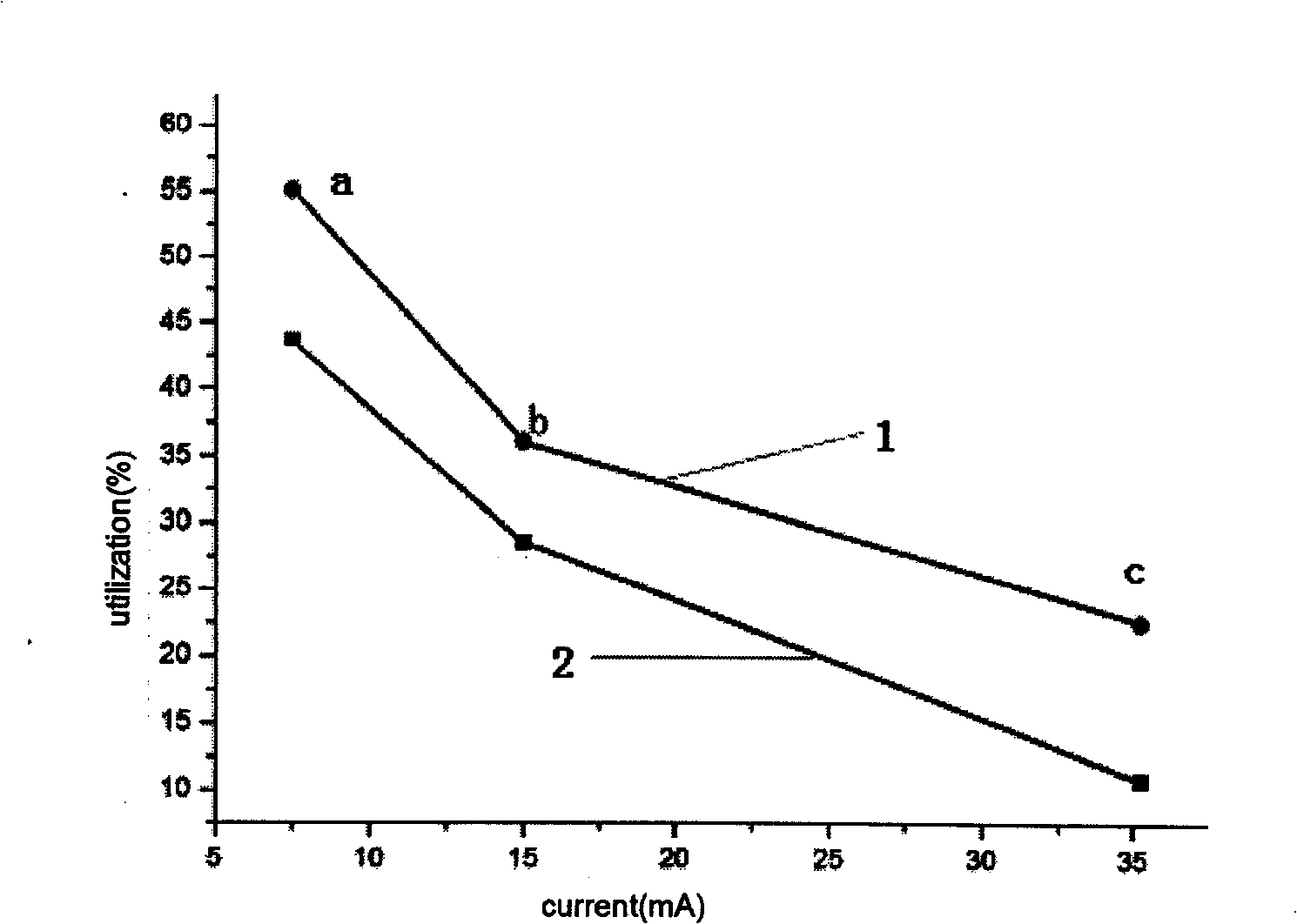Anode material of lead accumulator and preparation method thereof
A cathode material, lead battery technology, applied in lead-acid battery electrodes, battery electrodes, circuits, etc., can solve problems such as loss of function, and achieve the effects of improving utilization, reducing the influence of impurities, and improving the efficiency of formation
- Summary
- Abstract
- Description
- Claims
- Application Information
AI Technical Summary
Problems solved by technology
Method used
Image
Examples
Embodiment 1
[0024] 1) Mix 50g of concentrated sulfuric acid and 25g of concentrated nitric acid, then add 0.1g of sodium dodecylbenzenesulfonate and 0.1g of carbon nanotubes, stir and mix, then sonicate for 1 hour, add deionized water to dilute and suction filter until neutral, bake at 60°C 8h, to obtain mixed acid ultrasonic treatment of carbon nanotubes;
[0025] 2) Combine 0.1g polyacrylonitrile staple fiber with 30g PbO 2 Powder and 19.9g lead powder are mixed evenly;
[0026] 3) Put the mixture of mixed acid ultrasonically treated carbon nanotubes and step 2) into an agate ball mill jar at a mass ratio of 1:99, add 3ml of absolute ethanol dropwise therein, and ball mill at a speed of 200r / min for 2 hours to obtain an apparent density of 3.8 g / cm 3 positive electrode materials for lead-acid batteries. The positive electrode material of the lead storage battery contains 1% of carbon nanotubes, 0.5% of short polyacrylonitrile fibers, and Pb0 2 60%, the rest is lead powder.
[0027]...
Embodiment 2
[0029] 1) Mix 40g of concentrated sulfuric acid and 10g of concentrated nitric acid, then add 0.2g of sodium dodecylbenzenesulfonate and 0.2g of carbon nanotubes, stir and mix, then sonicate for 1 hour, add deionized water to dilute and filter until neutral, bake at 80°C 10h, to obtain mixed acid ultrasonic treatment of carbon nanotubes;
[0030] 2) Combine 0.5g polyacrylonitrile staple fiber with 35g PbO 2 Powder and 14.5g lead powder are mixed evenly;
[0031] 3) Put the mixture of mixed acid ultrasonically treated carbon nanotubes and step 2) into an agate ball mill jar at a mass ratio of 0.5:99.5, add 5ml of absolute ethanol dropwise therein, and ball mill at a speed of 200r / min for 3 hours to obtain an apparent density of 3.8 g / cm 3 positive electrode materials for lead-acid batteries. The positive electrode material of the lead storage battery contains 0.5% of carbon nanotubes, 1% of short polyacrylonitrile fibers, and Pb0 2 70%, the rest is lead powder.
[0032] A ...
Embodiment 3
[0034] 1) Mix 25g of concentrated sulfuric acid and 25g of concentrated nitric acid, then add 0.1g of polyvinyl alcohol and 0.1g of carbon nanotubes, stir and mix, then sonicate for 1h, add deionized water to dilute and filter until neutral, bake at 100°C for 12h, and obtain mixed acid sonication carbon nanotubes;
[0035] 2) Combine 1.0g polyacrylonitrile short fiber with 45g PbO 2 Powder and 4g lead powder are mixed evenly;
[0036] 3) Put the mixture of mixed acid ultrasonically treated carbon nanotubes and step 2) into an agate ball mill jar at a mass ratio of 2:98, add 3ml of absolute ethanol dropwise, and ball mill at a speed of 400r / min for 1h to obtain an apparent density of 4.3 g / cm 3 positive electrode materials for lead-acid batteries. Containing 2% of carbon nanotubes, 2% of short polyacrylonitrile fibers, and Pb0 in the positive electrode material of the lead storage battery 2 90%, the rest is lead powder.
[0037] A test electrode was prepared and tested usi...
PUM
| Property | Measurement | Unit |
|---|---|---|
| length | aaaaa | aaaaa |
| diameter | aaaaa | aaaaa |
| density | aaaaa | aaaaa |
Abstract
Description
Claims
Application Information
 Login to View More
Login to View More - R&D
- Intellectual Property
- Life Sciences
- Materials
- Tech Scout
- Unparalleled Data Quality
- Higher Quality Content
- 60% Fewer Hallucinations
Browse by: Latest US Patents, China's latest patents, Technical Efficacy Thesaurus, Application Domain, Technology Topic, Popular Technical Reports.
© 2025 PatSnap. All rights reserved.Legal|Privacy policy|Modern Slavery Act Transparency Statement|Sitemap|About US| Contact US: help@patsnap.com

